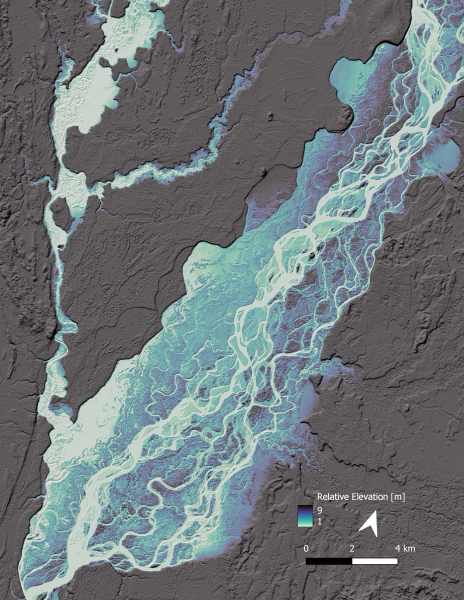River Belt Geology Helps Scientists Understand Ancient Mars Rivers
June 14, 2022

Long after a river has dried up, its channel belt lives on.
Made up of swaths of sediment surrounding the river, channel belts, once hardened into rock, preserve the paths of rivers that once were. However, reconstructing details about an ancient river from channel belt deposits is a notoriously difficult task.
New research from scientists at The University of Texas at Austin is making progress on that front. Lead author Tian Dong, a postdoctoral researcher at the UT Jackson School of Geosciences, said that by analyzing modern rivers they have been able to come up with a rule that connects channel belts to river patterns, finding that, in general, the more channels a river has, the narrower its channel belt.
Since the physics shaping rivers is the same over time and place, the rule should hold for ancient rivers and rivers on other planets, too, according to co-author Timothy Goudge, an assistant professor at the Jackson School.
“We can look at a river deposit from 100 million years ago on Earth or from 3.5 billion years ago on Mars and we can say something about what the actual river looked like,” he said.
The results were published on June 13 in the journal Geology.
In addition to helping scientists envision ancient rivers, the rule can also help them interpret how these rivers influenced the broader landscape. Rivers with narrower channel belts are able to more readily access the surrounding floodplain – which shapes how landscapes are built up and material is deposited downstream.
“For multichannel systems, such as braided rivers, they actually sit in a very narrow channel belt so they’re very close to the floodplain,” said Dong. “So potentially there’s more interaction between the river and floodplain material.”
The rule does have some caveats. It does not hold for confined rivers that are kept from freely migrating by their surrounding landscape. But when rivers are free to move and meander across the land there is a direct connection between an increasing number of river channels and a narrowing channel belt. The scientists also found that as the belt narrows, it also becomes smoother with less sharp edges.
The researchers discovered the rule by analyzing 30 modern rivers and their channel belts, drawing on high-resolution images and elevation data captured by satellites. Dong said that he had a hunch about the connection, noticing a trend between river channel and channel belt width from scrolling around on Google Earth. But he wasn’t sure if his intuition would prove correct once the data was computed.
“No one had really looked at the relationship between river and channel-belt planform shapes systematically, so we didn’t really know what we’d expect,” Dong said.
In addition to having narrower channel belts, the research also found that multichannel rivers take up more space on the channel belt, taking up 50% or more of the channel belt area. In contrast, single-channel systems, like meandering rivers, take up as little as 1%. This further boosts the ability of multichannel rivers to pick up and move sediments, Dong said. Since organic matter from plants and animals is among those sediments, it means that multichannel rivers may not store organic carbon on their floodplains as long before transporting it into the ocean – where it can affect sea life.
Channel belts are a common feature on Mars, serving as a reminder of the Red Planet’s wetter past. They are also probably found on Saturn’s moon Titan, where rivers of liquid methane have been identified by space probes.
Both Goudge and Dong said they hope to apply their research on rivers to learn about the geology that shapes other worlds.
“For future work, we will be looking to apply these metrics to other planets in our solar system and see what we can see,” Goudge said.
The research was funded by a Postdoctoral Fellowship award to Dong from the National Science Foundation.
This story originally published as “River Belt Discovery Helps Scientists Understand Ancient Rivers“, June 14, 2022 by the Jackson School of Geosciences.
